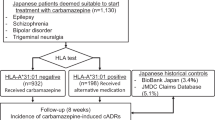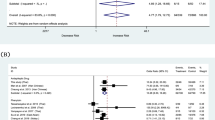Abstract
Xuesaitong (XST) is mainly used to treat cardiovascular and cerebrovascular diseases, sometimes causing cutaneous adverse drug reactions (cADRs) with unknown mechanisms of pathogenicity or risk factors. We aimed to verify whether human leukocyte antigen (HLA) alleles are associated with XST-related cADRs in Han Chinese population. We carried out an association study including 12 subjects with XST-induced cADRs, 283 controls, and 28 XST-tolerant subjects. Five out of 12 patients with XST-induced cADRs carried HLA-C*12:02, and all of them received XST via intravenous drip. The carrier frequency of HLA-C*12:02 was significantly high compare to that of the control population (Pc = 4.4 × 10−4, odds ratio (OR) = 21.75, 95% CI = 5.78–81.88). Compared with that of the XST-tolerant group, the patients who received XST through intravenous drip presented a higher OR of cADRs (Pc = 0.011, OR = 27.00, 95% CI = 2.58–282.98). The results suggest that HLA-C*12:02 is a potentially predictive marker of XST-induced cADRs in Han Chinese, especially when XST is administered via intravenous drip.
This is a preview of subscription content, access via your institution
Access options
Subscribe to this journal
Receive 6 print issues and online access
$259.00 per year
only $43.17 per issue
Buy this article
- Purchase on Springer Link
- Instant access to full article PDF
Prices may be subject to local taxes which are calculated during checkout


Similar content being viewed by others
References
Zhang X, Wu J, Zhang B. Xuesaitong injection as one adjuvant treatment of acute cerebral infarction: a systematic review and meta-analysis. BMC Complem Altern. 2015;15:36.
Yao DL. Curative effect of Xuesaitong injection on acute cerebral infarction of 50 patients. Prac Clin Med. 2007;12:21–2.
Yang PF, Song XY, Chen NH. Advances in pharmacological studies of Panax notoginseng saponins on brain ischemia-reperfusion injury. Acta Pharm Sin. 2016;51:1039–46.
He W, Xu XJ. Attenuation of brain inflammatory response after focal cerebral ischemia/reperfusion with Xuesaitong injection in rats. CHIN J INTEGR MED/1234. 2006;12:203–6.
Wang L, Li Z, Zhao X, Liu W, Liu Y, Yang J, et al. A network study of chinese medicine xuesaitong injection to elucidate a complex mode of action with multicompound, multitarget, and multipathway. Evid-Based Complement Altern Med. 2013;2013:652373.
Liu J, Sun K, Zheng C, Chen X, Zhang W, Wang Z. et al. Pathway as a pharmacological target for herbal medicines: an investigation from reduning injection. PLoS ONE. 2015;10:e0123109
Chen W. Analysis on 13 cases of adverse drug reaction by xuesaitong injection. J N Pharmacy 2013;5:16.
Ma H. 1 cases of severe erythematous erythematous drug eruption caused by Xuesaitong injection. Derm Vener Dis. 2007;29:57–57.
Ju H, Ming P, Zhong W, Wu L. 2 cases of Xuesaitong induced acute generalized exanthematous pustulosis. J Clin Dep Dermatol. 2005;34:693–4.
Xiang Z, Qiao T, Xiao H, Kang T-G, Dou D, Li H, et al. The anaphylactoid constituents in Xue-Sai-Tong injection. Planta Med. 2013;79:1043–50.
Xu Y, Dou D, Ran X, Liu C, Chen J. Integrative analysis of proteomics and metabolomics of anaphylactoid reaction induced by Xuesaitong injection. J Chromatogr. 2015;1416:103–11.
Cao ZH, Wei ZY, Zhu QY, Zhang JY, Yang L, Qin SY, et al. HLA-B*58:01 allele is associated with augmented risk for both mild and severe cutaneous adverse reactions induced by allopurinol in Han Chinese. Pharmacogenomics. 2012;13:1193–201.
Mallal S, Phillips E, Carosi G, Molina JM, Workman C, Tomazic J, et al. HLA-B*5701 screening for hypersensitivity to abacavir. N Engl J Med. 2008;358:568–79.
Barbaud A, Waton J, Herbeth B, Bursztejn AC, Bollaert M, Schmutz JL, et al. Comparison of cytokine gene polymorphism in drug-induced maculopapular eruption, urticaria and drug reaction with eosinophilia and systemic symptoms (DRESS). J Eur Acad Dermatol Venereol. 2014;28:491–9.
Ueta M, Sotozono C, Inatomi T, Kojima K, Hamuro J, Kinoshita S. Association of Fas Ligand gene polymorphism with Stevens-Johnson syndrome. Br J Ophthalmol. 2008;92:989–91.
Bharadwaj M, Illing P, Theodossis A, Purcell AW, Rossjohn J, McCluskey J. Drug hypersensitivity and human leukocyte antigens of the major histocompatibility complex. Annu Rev Pharmacol Toxicol. 2012;52:401–31.
Goncalo M, Coutinho I, Teixeira V, Gameiro AR, Brites MM, Nunes R, et al. HLA-B*58:01 is a risk factor for allopurinol-induced DRESS and Stevens-Johnson syndrome/toxic epidermal necrolysis in a Portuguese population. Br J Dermatol. 2013;169:660–5.
Zhang Y, Wang J, Zhao LM, Peng W, Shen GQ, Xue L, et al. Strong association between HLA-B*1502 and carbamazepine-induced Stevens-Johnson syndrome and toxic epidermal necrolysis in mainland Han Chinese patients. Eur J Clin Pharmacol. 2011;67:885–7.
Chen P, Lin JJ, Lu CS, Ong CT, Hsieh PF, Yang CC, et al. Carbamazepine-induced toxic effects and HLA-B*1502 screening in Taiwan. N Engl J Med. 2011;364:1126–33.
Illing PT, Vivian JP, Purcell AW, Rossjohn J, McCluskey J. Human leukocyte antigen-associated drug hypersensitivity. Curr Opin Immunol. 2013;25:81–9.
Son YM, Lee JR, Roh JY. Causality assessment of cutaneous adverse drug reactions. Ann Dermatol. 2011;23:432–8.
Kitts A, Feolo M, Helmberg W. The major histocompatibility complex database, DBMHC. In: Jo Mc-Entyre, editor. The NCBI handbook - NCBI Bookshelf. Bethesda, MD: National Center for Biotechnology Information; 2003.
Trachtenberg E, Vinson M, Hayes E, Hsu YM, Houtchens K, Erlich H, et al. HLA class I (A, B, C) and class II (DRB1, DQA1, DQB1, DPB1) alleles and haplotypes in the Han from southern China. Tissue Antigens. 2007;70:455–63.
Yan S, Chen SA, Zhang W, Yang F, Yang Y, Zhu Q, et al. HLA-A*02 alleles are associated with tetanus antitoxin-induced exanthematous drug eruptions in Chinese patients. Pharm Genom. 2016;26:538–46.
Rteam R, Team R, Development Core, Team R, Team R, Null RDCT. R: a language and environment for statistical computing. Computing. 2014;14:12–21.
Haldane JB. The estimation and significance of the logarithm of a ratio of frequencies. Ann Hum Genet. 1956;20:309–11.
Yang F, Gu B, Zhang L, Xuan J, Luo H, Zhou P, et al. HLA-B*13:01 is associated with salazosulfapyridine-induced drug rash with eosinophilia and systemic symptoms in Chinese Han population. Pharmacogenomics. 2014;15:1461–9.
Berman HM, Westbrook J, Feng Z, Gilliland G, Bhat TN, Weissig H, et al. The protein data bank. Nucleic Acids Res. 2000;28:235–42.
Kaur G, Gras S, Mobbs JI, Vivian JP, Cortes A, Barber T, et al. Structural and regulatory diversity shape HLA-C protein expression levels. NAT COMMUN/11329. 2017;8:15924.
Schwede T, Kopp J, Guex N, Peitsch MC. SWISS-MODEL: An automated protein homology-modeling server. Nucleic Acids Res. 2003;31:3381–5.
Emsley P, Lohkamp B, Scott WG, Cowtan K. Features and development of Coot. Acta Crystallogr D Biol Crystallogr. 2010;66:486–501.
Delano WL. The PyMOL molecular graphics system. My Publ. 2002;30:442–54.
Unni S, Huang Y, Hanson RM, Tobias M, Krishnan S, Li WW, et al. Web servers and services for electrostatics calculations with APBS and PDB2PQR. J Comput Chem. 2011;32:1488–91.
Pirmohamed M. Pharmacogenetics of idiosyncratic adverse drug reactions. Handb Exp Pharmacol. 2010;196:477–91.
Posadas SJ, Pichler WJ. Delayed drug hypersensitivity reactions - new concepts. Clin Exp Allerg. 2007;37:989–99.
Yang Y, Chen S, Yang F, Zhang L, Alterovitz G, Zhu H, et al. HLA-B*51:01 is strongly associated with clindamycin-related cutaneous adverse drug reactions. Pharmacogenomics J. 2016;17:501–5.
Pistone G, Gurreri R, Alaimo R, Curiale S, Bongiorno MR. Gender differences in adverse drug reactions in dermatological patients in west Sicily: an epidemiological study. J Dermatol Treat. 2014;25:510–2.
Nicolson TJ, Mellor HR, Roberts RR. Gender differences in drug toxicity. Trends Pharmacol Sci. 2010;31:108–14.
Loll B, Fabian H, Huser H, Hee CS, Ziegler A, Uchanska-Ziegler B, et al. Increased conformational flexibility of HLA-B*27 subtypes associated with ankylosing spondylitis. Arthritis Rheumatol. 2016;68:1172–82.
Mabuchi T, Ota T, Manabe Y, Ikoma N, Ozawa A, Terui T, et al. HLA-C*12:02 is a susceptibility factor in late-onset type of psoriasis in Japanese. J Dermatol. 2014;41:697–704.
Liao H-T, Lin K-C, Chang Y-T, Chen C-H, Liang T-H, Chen W-S, et al. Human leukocyte antigen and clinical and demographic characteristics in psoriatic arthritis and psoriasis in Chinese patients. J Rheumatol. 2008;35:891–5.
Yun J, Mattsson J, Schnyder K, Fontana S, Largiadèr CR, Pichler WJ, et al. Allopurinol hypersensitivity is primarily mediated by dose-dependent oxypurinol-specific T cell response. Clin Exp Allergy. 2013;43:1246–55.
Liu Y, Ma H, Zhang JW, Deng MC, Yang L. Influence of ginsenoside Rh1 and F1 on human cytochrome p450 enzymes. Planta Med. 2006;72:126–31.
Han M, Fu S, Fang XL. [Comparison between the characteristics of absorption and pharmacokinetic behavior of ginsenoside Rg1 and ginsenoside Rb, of Panax notoginseng saponins]. Yao xue xue bao = Acta Pharm Sin. 2007;42:849.
Liu Y, Zhang JW, Li W, Ma H, Sun J, Deng MC, et al. Ginsenoside metabolites, rather than naturally occurring ginsenosides, lead to inhibition of human cytochrome P450 enzymes. Toxicol Sci. 2006;91:356–64.
Zhang QY, Dunbar D, Ostrowska A, Zeisloft S, Yang J, Kaminsky LS. Characterization of human small intestinal cytochromes P-450. Drug Metab Dispos. 1999;27:804–9.
Nelson MR, Bacanu SA, Mosteller M, Li L, Bowman CE, Roses AD, et al. Genome-wide approaches to identify pharmacogenetic contributions to adverse drug reactions. Pharmacogenomics J. 2008;9:23–33.
Acknowledgements
This work was supported by the National Key Research and Development Program (2016YFC0905000, 2016 YFC0905001), the National Natural Science Foundation of China (grants 81472873, 81071287, 31371274, 81770725 and 81650004), Science and Technology Commission of Shanghai Municipality (14DJ1400100), Scientific and Technological Research in Open Collaborative Projects of Henan Province (152106000044) and HHS|NIH|U.S. National Library of Medicine (4R00LM009826-03). We thank the patients for their cooperation.
Author information
Authors and Affiliations
Corresponding authors
Ethics declarations
Conflict of interest
The authors declare that they have no conflict of interest.
Electronic supplementary material
Rights and permissions
About this article
Cite this article
Yan, S., Xiong, H., Shao, F. et al. HLA-C*12:02 is strongly associated with Xuesaitong-induced cutaneous adverse drug reactions. Pharmacogenomics J 19, 277–285 (2019). https://doi.org/10.1038/s41397-018-0051-3
Received:
Revised:
Accepted:
Published:
Issue Date:
DOI: https://doi.org/10.1038/s41397-018-0051-3



